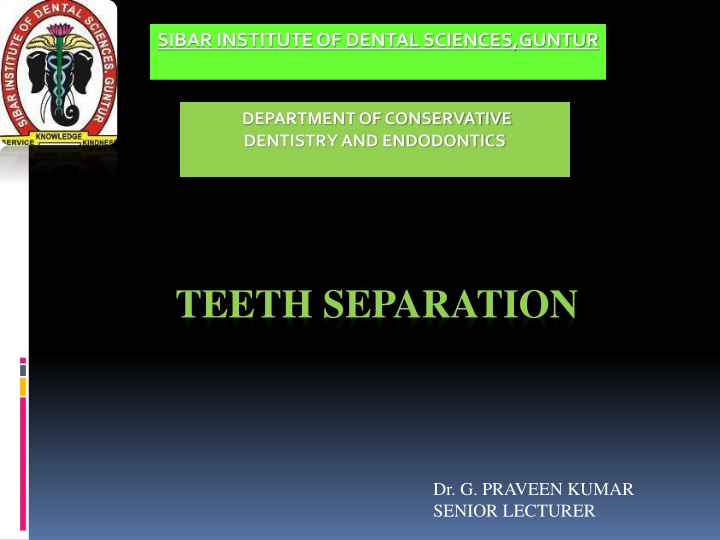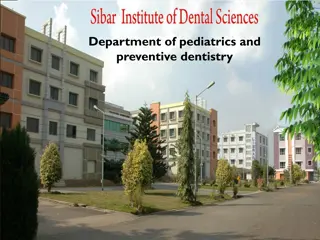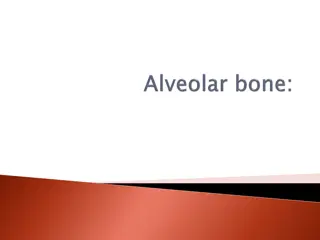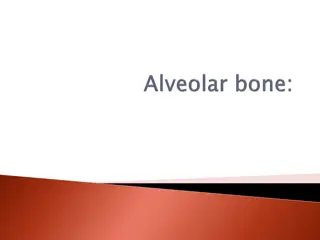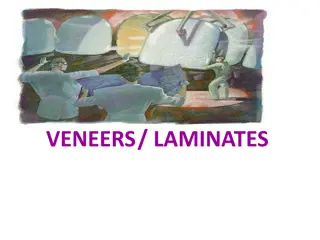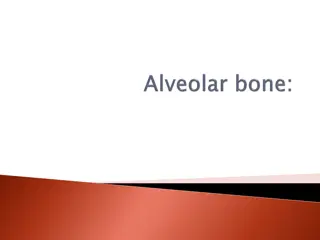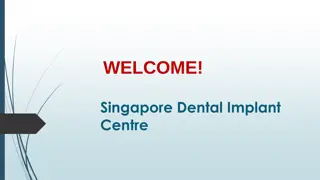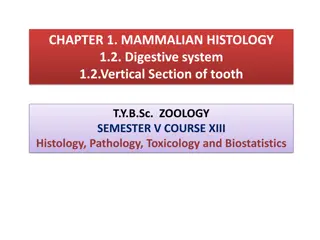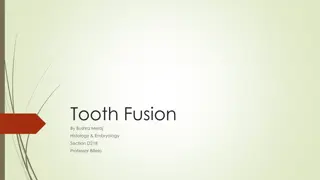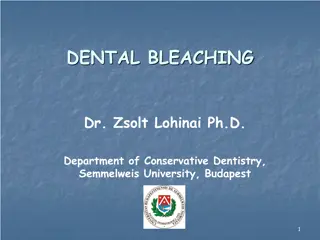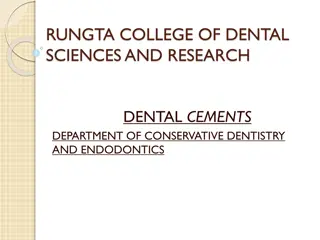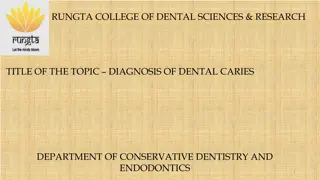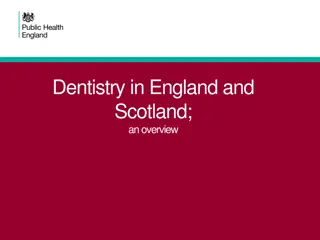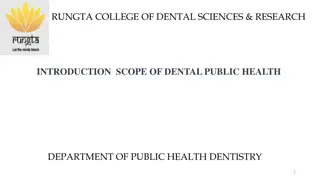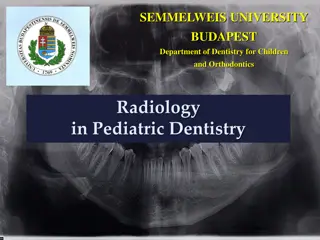Tooth Separation in Conservative Dentistry and Endodontics: Methods and Importance
Tooth separation is essential in restorative procedures to enhance convenience, achieve proper contacts and contours, improve operative treatment outcomes, and maintain oral health. This process involves slightly moving teeth apart or closer, or changing their spatial position. Different methods such as rapid and slow tooth separation are employed, each with its techniques like using wedges, separators, rubber dams, rubber bands, ligature wires, resin temporaries, and orthodontic appliances.
Download Presentation

Please find below an Image/Link to download the presentation.
The content on the website is provided AS IS for your information and personal use only. It may not be sold, licensed, or shared on other websites without obtaining consent from the author.If you encounter any issues during the download, it is possible that the publisher has removed the file from their server.
You are allowed to download the files provided on this website for personal or commercial use, subject to the condition that they are used lawfully. All files are the property of their respective owners.
The content on the website is provided AS IS for your information and personal use only. It may not be sold, licensed, or shared on other websites without obtaining consent from the author.
E N D
Presentation Transcript
SIBAR INSTITUTE OF DENTAL SCIENCES,GUNTUR DEPARTMENT OF CONSERVATIVE DENTISTRY AND ENDODONTICS TEETH SEPARATION Dr. G. PRAVEEN KUMAR SENIOR LECTURER
Table of contents: 1. Definition 2. Need for tooth separation 3. Methods of tooth separation: a. Rapid or Immediate tooth separation : Separation by wedge principle- i) Elliot s separator ii) wedges Separation by traction principle- i)Non interfering true separator ii) Ferrier double bow separator
b. Slow or delayed tooth separation: Rubber dam sheets Separating rubber band Separating ligature wires Oversized resin temporaries Orthodontic appliances
Introduction: Separation of teeth may be necessary during some restorative procedures in order to : Improve convenience form Achieve functional contacts, contours & occlusion Enhance the excellence of operative treatment Improve health of both teeth & their supporting tissues.
Definition: Tooth movement or separation is process of separating the involved teeth slightly away from each other or bringing them closer to each other, &/ or changing their spatial position in one or more direction.
Need for tooth separation: Diagnosis Cavity preparation Matrix placement Polishing restorations Repositioning drifted teeth Removal of foreign objects
Methods of tooth separation: Two methods: Rapid or Immediate tooth separation Slow or Delayed tooth separation
RAPID OR IMMEDIATE TOOTH SEPARATION:
RAPID OR IMMEDIATE TOOTH SEPARATION: Tooth movement is achieved rapidly over short period of time, by wedge or traction principle. Tooth movement should not exceed thickness of involved tooth s periodontal ligament, i.e appx. 0.2 -0.5 mm . More separation can tear ligaments at one site & crush them at other.
Separation by wedge principle: A pointed wedge shaped device is inserted between the contacting teeth to produce the desired amount of separation. Eg: Elliot s separator Wedges
ELLIOTS SEPARATOR: Single bow separator. Works on wedging principle Advantage : screw may be removed for use on either side, permitting adjustments for convenience on both side of arch. Disadvantage : separator has tendancy to drift cervically.
WEDGES: Create rapid separation during tooth preparation & restoration. Wedges are small, tapering, triangular pieces of wood or clear plastic about inch in length.
Separation by Traction principle: Non- interfering true separator Ferrier double bow separator Ivory adjustable separator Woodward separator Parr s universal separator Dentatus Nystrom separator
Non-interfering true separator: Indicated when continuous stabilised separation is required. Advantages : Separation can be increased or decreased after stabilisation. Device is non-interfering.
Separator stabilization: Apply piece of softened compound to teeth under separator by introducing it in buccal & lingual embrasures.
Ferrier double bow separator: Available in size 1-6. Smaller no. 1&2 are used for most anterior teeth. Separation is stabilised throughout operation. Its advantage is that the separation is shared by contacting teeth & not at expense of one tooth as with non-interfering true separator.
SLOW OR DELAYED TOOTH MOVEMENT: When teeth have drifted or tilted considerably, rapid movement of teeth to proper position will endanger periodontal ligament. Therefore, slow teeth movement over period of days/weeks/months/year, will allow proper repositioning of teeth in physiologic manner. Methods : Rubber dam sheet Separating rubber band Separating ligature wires Oversized resin temporary crowns Orthodontic appliances
Rubber dam sheet: A small piece of heavy or extra heavy rubber dam sheet can be stretched & positioned in contact area b/w teeth. Separation occurs due to thickness of sheet, approaching passive thickness of sheet. Time for separation ranges from 1 hr to 24 hrs or more. In case pain develops rubber dam piece should be removed by dental floss.
Separating rubber band: Separating rubber bands used for orthodontic purposes can be used. It is positioned interproximally b/w teeth to produce slow separation.
Separating ligature wires or steel separating rings: 1. Brass ligature wire 2. steel separating rings
Oversized resin temporary crowns: Resin temporaries which are oversized mesio- distally may achieve slow separation. Resin is added to contact areas periodically to increase amount of separation, which should not exceed 0.5mm per visit.
Orthodontic appliances: Fixed orthodontic appliances are most effective & predictable means of achieving slow teeth movement. Used when extensive repositioning is required.
References: Art and science of operative dentistry sturdevants Textbook of operative dentistry Vimal K Sikri Textbook of operative dentistry Nisha Garg Textbook of operative dentistry Ramya Raghu
